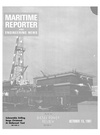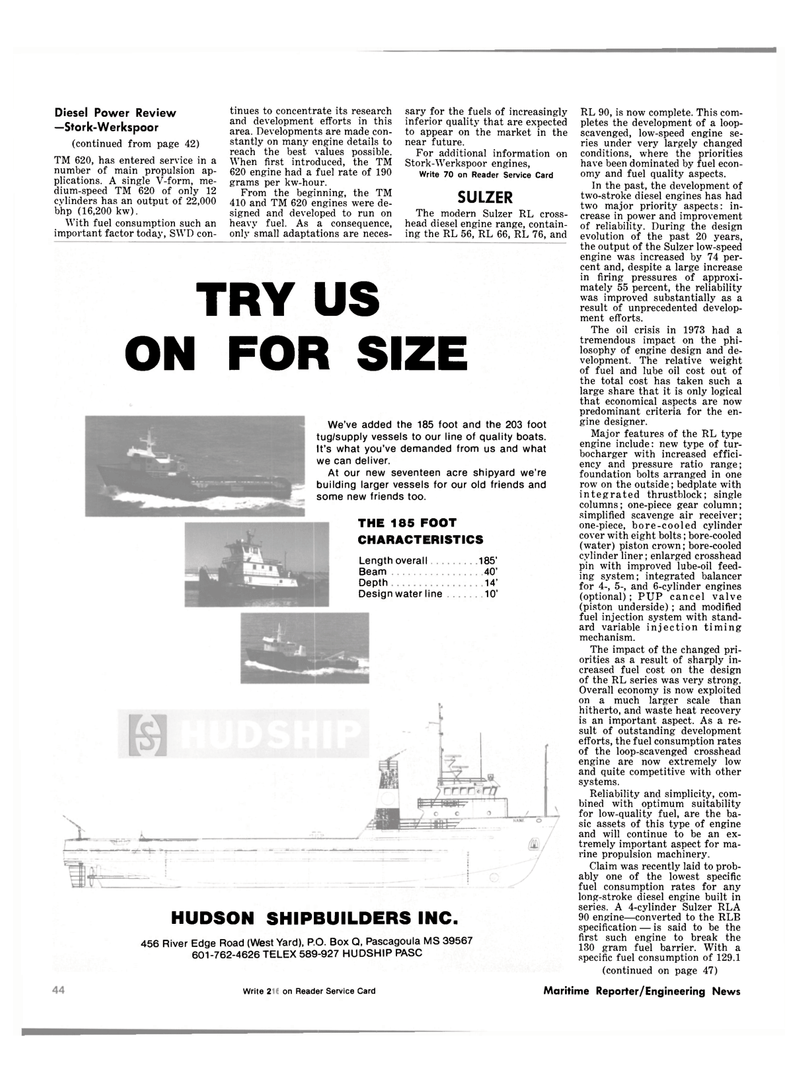
Page 40: of Maritime Reporter Magazine (October 15, 1981)
Read this page in Pdf, Flash or Html5 edition of October 15, 1981 Maritime Reporter Magazine
Diesel Power Review —Stork-Werkspoor (continued from page 42)
TM 620, has entered service in a number of main propulsion ap- plications. A single V-form, me- dium-speed TM 620 of only 12 cylinders has an output of 22,000 bhp (16,200 kw).
With fuel consumption such an important factor today, SWD con- tinues to concentrate its research and development efforts in this area. Developments are made con- stantly on many engine details to reach the best values possible.
When first introduced, the TM 620 engine had a fuel rate of 190 grams per kw-hour.
From the beginning, the TM 410 and TM 620 engines were de- signed and developed to run on heavy fuel. As a consequence, only small adaptations are neces- sary for the fuels of increasingly inferior quality that are expected to appear on the market in the near future.
For additional information on
Stork-Werkspoor engines,
Write 70 on Reader Service Card
SULZER
The modern Sulzer RL cross- head diesel engine range, contain- ing the RL 56, RL 66, RL 76, and
TRY US
ON FOR SIZE
We've added the 185 foot and the 203 foot tug/supply vessels to our line of quality boats.
It's what you've demanded from us and what we can deliver.
At our new seventeen acre shipyard we're building larger vessels for our old friends and some new friends too.
THE 185 FOOT
CHARACTERISTICS
Length overall 185'
Beam 40
Depth 14'
Design water line 10'
HUDSON SHIPBUILDERS INC. 456 River Edge Road (West Yard), P.O. Box Q, Pascagoula MS 39567 601-762-4626 TELEX 589-927 HUDSHIP PASC
RL 90, is now complete. This com- pletes the development of a loop- scavenged, low-speed engine se- ries under very largely changed conditions, where the priorities have been dominated by fuel econ- omy and fuel quality aspects.
In the past, the development of two-stroke diesel engines has had two major priority aspects: in- crease in power and improvement of reliability. During the design evolution of the past 20 years, the output of the Sulzer low-speed engine was increased by 74 per- cent and, despite a large increase in firing pressures of approxi- mately 55 percent, the reliability was improved substantially as a result of unprecedented develop- ment efforts.
The oil crisis in 1973 had a tremendous impact on the phi- losophy of engine design and de- velopment. The relative weight of fuel and lube oil cost out of the total cost has taken such a large share that it is only logical that economical aspects are now predominant criteria for the en- gine designer.
Major features of the RL type engine include: new type of tur- bocharger with increased effici- ency and pressure ratio range; foundation bolts arranged in one row on the outside; bedplate with integrated thrustblock; single columns; one-piece gear column; simplified scavenge air receiver; one-piece, bore-cooled cylinder cover with eight bolts; bore-cooled (water) piston crown; bore-cooled cylinder liner; enlarged crosshead pin with improved lube-oil feed- ing system; integrated balancer for 4-, 5-, and 6-cylinder engines (optional); PUP cancel valve (piston underside) ; and modified fuel injection system with stand- ard variable injection timing mechanism.
The impact of the changed pri- orities as a result of sharply in- creased fuel cost on the design of the RL series was very strong.
Overall economy is now exploited on a much larger scale than hitherto, and waste heat recovery is an important aspect. As a re- sult of outstanding development efforts, the fuel consumption rates of the loop-scavenged crosshead engine are now extremely low and quite competitive with other systems.
Reliability and simplicity, com- bined with optimum suitability for low-quality fuel, are the ba- sic assets of this type of engine and will continue to be an ex- tremely important aspect for ma- rine propulsion machinery.
Claim was recently laid to prob- ably one of the lowest specific fuel consumption rates for any long-stroke diesel engine built in series. A 4-cylinder Sulzer RLA 90 engine—converted to the RLB specification — is said to be the first such engine to break the 130 gram fuel barrier. With a specific fuel consumption of 129.1 (continued on page 47) 14
Write 142 on Reader Service Card Maritime Reporter/Engineering News

 39
39

 41
41
